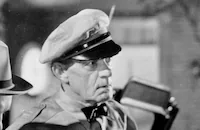The Nitwits

Brief Synopsis
Cast & Crew
George Stevens
Bert Wheeler
Robert Woolsey
Fred Keating
Betty Grable
Evelyn Brent
Film Details
Technical Specs

Synopsis
After music publisher Winfield Lake receives an extortion letter from someone calling himself The Black Widow, his wife Alice insists that he hire William Darrell, a famous private detective, to protect him. As Darrell begins his assignment for Lake, unsuspecting Johnny and Newton, who run the cigar store in Lake's office building, audition their new song, "The Black Widow Is Going to Get You If You Don't Watch Out," for him. Terrified, Lake angrily rejects the song and storms up to his office, where he is greeted by songwriter George Clark, who charges him with cheating on his royalty payments. Lake then accuses Lurch, his auditor, of tampering with the account books and assures Clark that he will investigate the matter. After locking Clark's file in his desk, Lake flirts with his secretary, Mary Roberts, who is also Johnny's girl friend. When Johnny shows up with an unloaded gun to "plug" his song again, he sees Lake being repulsed by Mary and slugs him, then announces that Mary is quitting. While Mary prepares to go, Lake is murdered by The Black Widow, who fires his gun through a hole hidden in the ceiling. Caught hiding on the balcony with Johnny's gun, Mary is arrested in spite of "confessions" from both Johnny and Newton. That night Johnny and Newton visit Mary's jail cell and learn that she saw Lurch trying to break into Lake's desk shortly after the murder. Determined to help Mary, Johnny and Newton return to the Lake Building to plant Newton's "truth device" invention on Lake's chair and then trick Lurch into confessing. At the same time, the police surround the building in order to catch The Black Widow, who is to collect extortion money that has been deposited by Alice and others in the basement. While Johnny and Newton set up their device, Darrell shows up and suggests that they re-enact the crime. By accident, Darrell activates the truth device and confesses that he is The Black Widow, but Johnny and Newton conclude that the device has malfunctioned and proceed with the re-enactment. After the boys barely escape with their lives, Darrell murders Lurch, who has shown up to retrieve Clark's file, and then knocks out Clark as he arrives on the scene. A group of blacks, meanwhile, who have snuck into a costume company office to play a game of craps, discover Darrell's money, which has blown up the ventilation shaft from the basement, in a heating grate. To retrieve his money, Darrell dons a "skeleton" costume and scares the blacks, but is then confronted by Johnny and Newton. After an extended chase and fight involving Darrell, his men, the blacks, and Johnny and Newton, the police burst in and apprehend Darrell. Cleared of all charges, Mary accepts both Johnny's proposal and his pegboard engagement ring.

Director

George Stevens
Cast

Bert Wheeler

Robert Woolsey
Fred Keating

Betty Grable

Evelyn Brent

Erik Rhodes

Hale Hamilton
Charles Wilson
Arthur Aylesworth

Willie Best

Lew Kelly
Dorothy Granger
Edgar Dearing
Crew
Felix Bernard
Al Boasberg
Edward Cronjager
P. J. Faulkner Jr.
Perry Ferguson
Dorothy Fields
Grant Garrett
L. Wolfe Gilbert
Leslie Goodwins
Fred Guiol
John Lockert
Lee Marcus
Jimmy Mchugh
Stuart Palmer
Van Nest Polglase
Roy Webb

Videos
Movie Clip



Film Details
Technical Specs

Articles
The Nitwits -
By Richard Harland Smith

The Nitwits -
Quotes
Trivia
Notes
The working titles of this film were Nitwits and Murder Song. According to a Hollywood Reporter production chart, Bill Wells, Etienne Girardot and Robert Middlemass were cast members, but their participation in the final film has not been confirmed.














